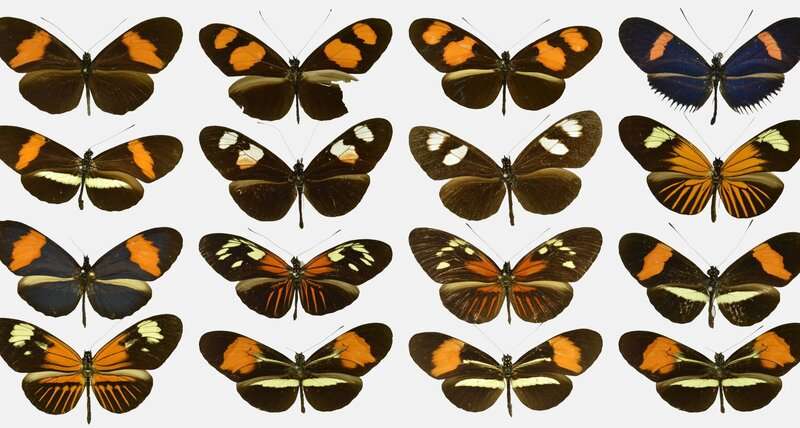Researchers have used artificial intelligence to make new discoveries, and confirm old ones, about one of nature’s best-known mimics, opening up whole new directions of research in evolutionary biology.
copyright by phys.org
 The researchers, from the University of Cambridge, the University of Essex, the Tokyo Institute of Technology and the Natural History Museum London used their machine learning algorithm to test whether butterfly species can co-evolve similar wing patterns for mutual benefit. This phenomenon, known as Müllerian mimicry, is considered evolutionary biology ‘s oldest mathematical model and was put forward less than two decades after Darwin’s theory of evolution by natural selection.
The researchers, from the University of Cambridge, the University of Essex, the Tokyo Institute of Technology and the Natural History Museum London used their machine learning algorithm to test whether butterfly species can co-evolve similar wing patterns for mutual benefit. This phenomenon, known as Müllerian mimicry, is considered evolutionary biology ‘s oldest mathematical model and was put forward less than two decades after Darwin’s theory of evolution by natural selection.
The algorithm was trained to quantify variation between different subspecies of Heliconius butterflies, from subtle differences in the size, shape, number, position and colour of wing pattern features, to broad differences in major pattern groups.
This is the first fully automated, objective method to successfully measure overall visual similarity, which by extension can be used to test how species use wing pattern evolution as a means of protection. The results are reported in the journal Science Advances.
The researchers found that different butterfly species act both as model and as mimic, ‘borrowing’ features from each other and even generating new patterns.
“We can now apply AI in new fields to make discoveries which simply weren’t possible before,” said lead author Dr. Jennifer Hoyal Cuthill from Cambridge’s Department of Earth Sciences. “We wanted to test Müller’s theory in the real world: did these species converge on each other’s wing patterns and if so how much? We haven’t been able to test mimicry across this evolutionary system before because of the difficulty in quantifying how similar two butterflies are.”
Müllerian mimicry theory is named after German naturalist Fritz Müller, who first proposed the concept in 1878, less than two decades after Charles Darwin published On the Origin of Species in 1859. Müller’s theory proposed that species mimic each other for mutual benefit. This is also an important case study for the phenomenon of evolutionary convergence, in which the same features evolve again and again in different species.
For example, Müller’s theory predicts that two equally bad-tasting or toxic butterfly populations in the same location will come to resemble each other because both will benefit by ‘sharing’ the loss of some individuals to predators learning how bad they taste. This provides protection through cooperation and mutualism. It contrasts with Batesian mimicry, which proposes that harmless species mimic harmful ones to protect themselves.
Thank you for reading this post, don't forget to subscribe to our AI NAVIGATOR!
Heliconius butterflies are well-known mimics, and are considered a classic example of Müllerian mimicry. They are widespread across tropical and sub-tropical areas in the Americas. There are more than 30 different recognisable pattern types within the two species that the study focused on, and each pattern type contains a pair of mimic subspecies.[…]
read more – copyright by phys.org
Picture Credit: J Hoyal Cuthill


Researchers have used artificial intelligence to make new discoveries, and confirm old ones, about one of nature’s best-known mimics, opening up whole new directions of research in evolutionary biology.
copyright by phys.org
The algorithm was trained to quantify variation between different subspecies of Heliconius butterflies, from subtle differences in the size, shape, number, position and colour of wing pattern features, to broad differences in major pattern groups.
This is the first fully automated, objective method to successfully measure overall visual similarity, which by extension can be used to test how species use wing pattern evolution as a means of protection. The results are reported in the journal Science Advances.
The researchers found that different butterfly species act both as model and as mimic, ‘borrowing’ features from each other and even generating new patterns.
“We can now apply AI in new fields to make discoveries which simply weren’t possible before,” said lead author Dr. Jennifer Hoyal Cuthill from Cambridge’s Department of Earth Sciences. “We wanted to test Müller’s theory in the real world: did these species converge on each other’s wing patterns and if so how much? We haven’t been able to test mimicry across this evolutionary system before because of the difficulty in quantifying how similar two butterflies are.”
Müllerian mimicry theory is named after German naturalist Fritz Müller, who first proposed the concept in 1878, less than two decades after Charles Darwin published On the Origin of Species in 1859. Müller’s theory proposed that species mimic each other for mutual benefit. This is also an important case study for the phenomenon of evolutionary convergence, in which the same features evolve again and again in different species.
For example, Müller’s theory predicts that two equally bad-tasting or toxic butterfly populations in the same location will come to resemble each other because both will benefit by ‘sharing’ the loss of some individuals to predators learning how bad they taste. This provides protection through cooperation and mutualism. It contrasts with Batesian mimicry, which proposes that harmless species mimic harmful ones to protect themselves.
Thank you for reading this post, don't forget to subscribe to our AI NAVIGATOR!
Heliconius butterflies are well-known mimics, and are considered a classic example of Müllerian mimicry. They are widespread across tropical and sub-tropical areas in the Americas. There are more than 30 different recognisable pattern types within the two species that the study focused on, and each pattern type contains a pair of mimic subspecies.[…]
read more – copyright by phys.org
Picture Credit: J Hoyal Cuthill
Share this: